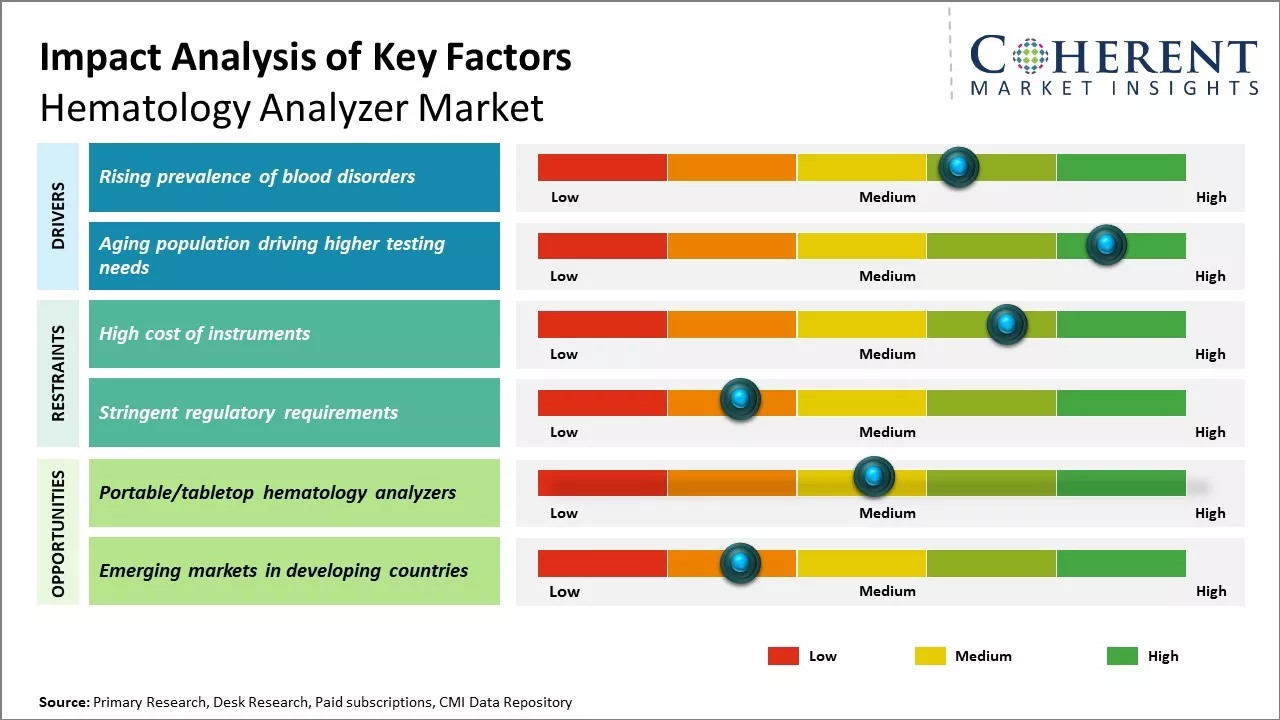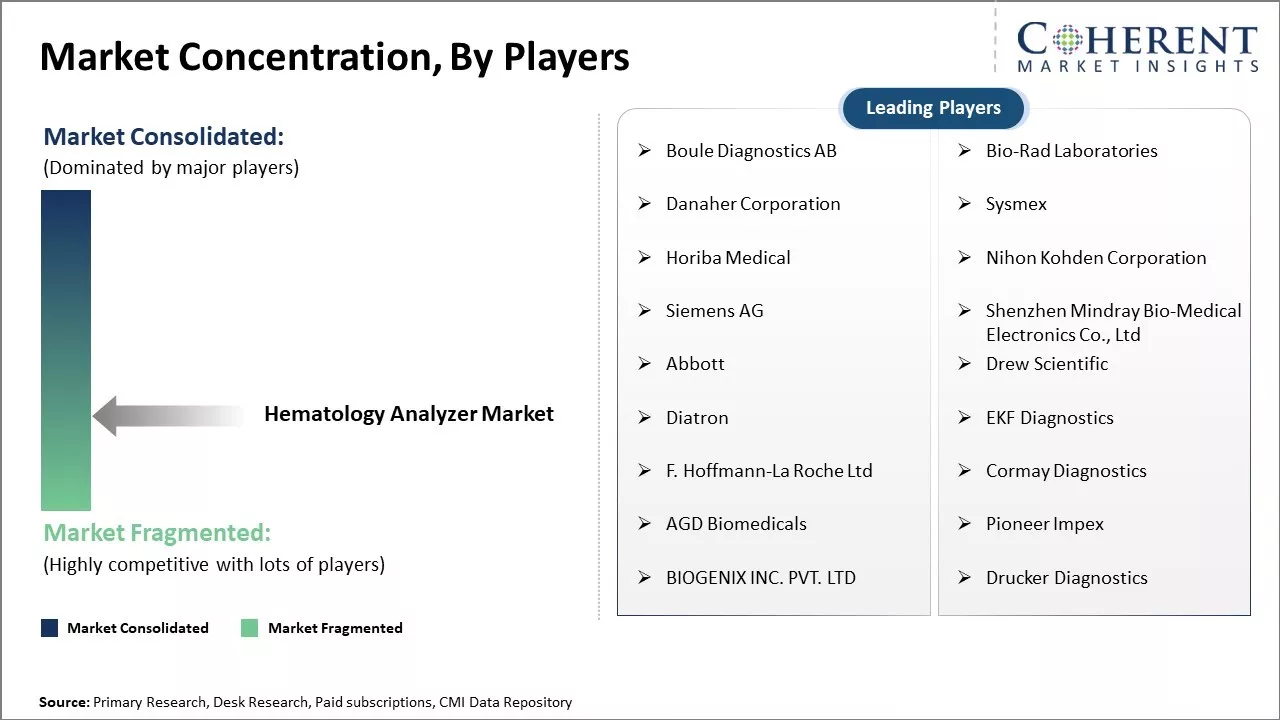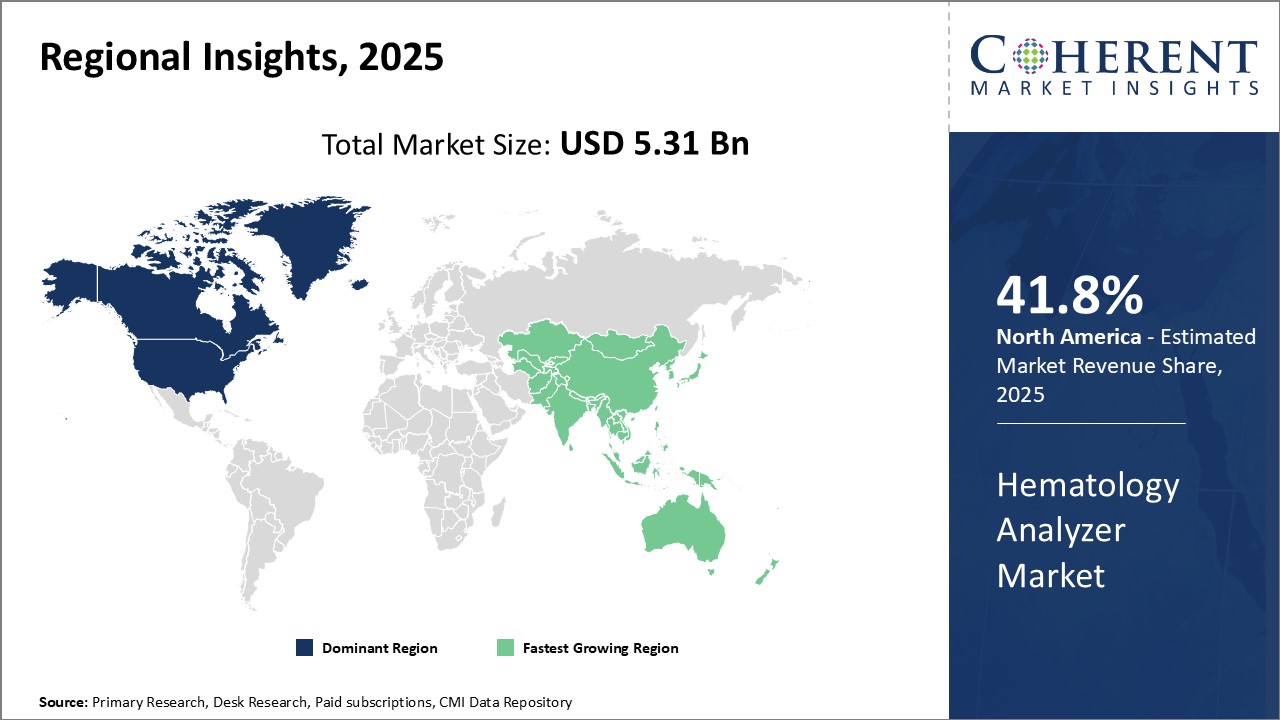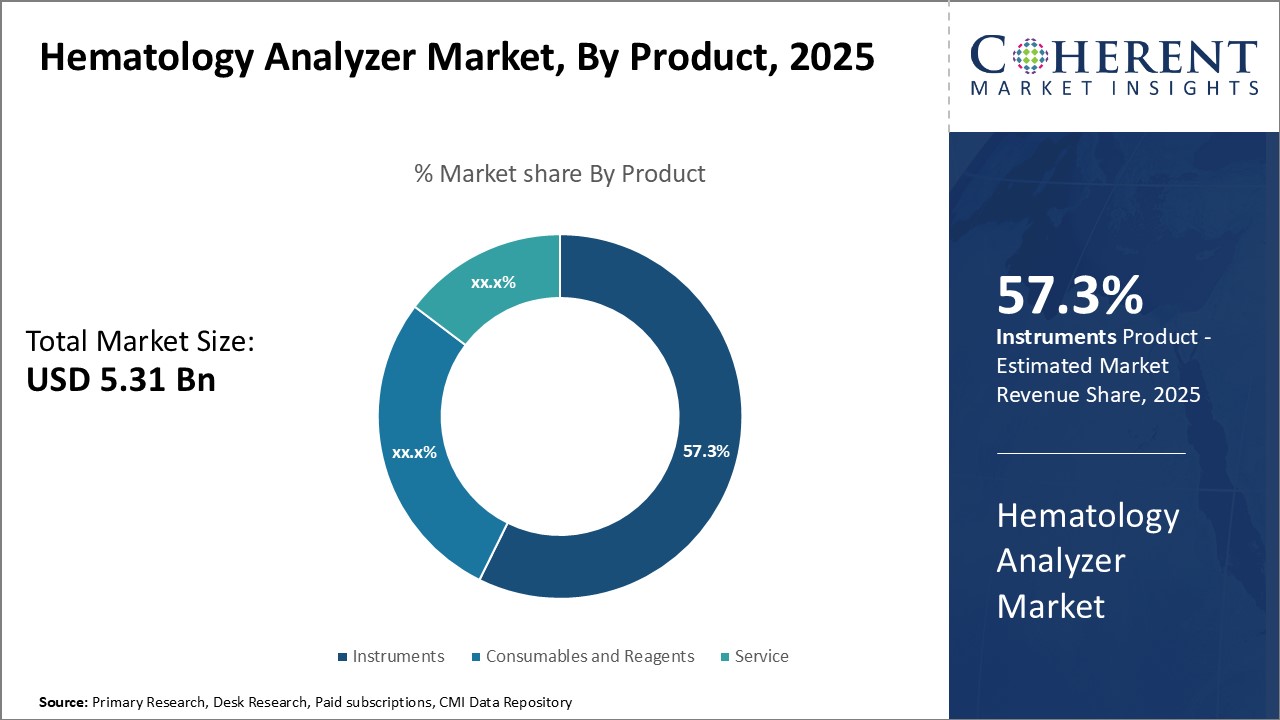Hematology Analyzer Market Size And Share Analysis - Growth Trends And Forecasts (2025-2032)
The hematology analyzer market is estimated to be valued at USD 5.31 Bn in 2025 and is expected to reach USD 8.82 Bn by 2032, exhibiting a compound annual growth rate (CAGR) of 7.5% from 2025 to 2032.

To learn more about this report, Download Free Sample
Key Takeaways
- By Product, the instruments segment is projected to dominate the global hematology analyser market, holding a commanding 57.3% share in 2025. This dominance is driven by continual advancements in analytical technologies, automation features, and integrated software that enhance diagnostic accuracy and speed.
- By Modality, the Fully-automated hematology analyzers are estimated to lead the modality segment with a substantial 63.3% market share in 2025.
- By End User, Diagnostic laboratories are anticipated to lead the end-user segment, accounting for 42.1% of the market share in 2025.
- North America is expected to retain its leadership in the global hematology analyzer market, capturing an estimated 41.8% market share in 2025.
Market Overview
The global Hematology Analyzer Market is witnessing robust growth, propelled by rising demand for accurate, automated blood diagnostics, increasing prevalence of blood disorders, and expanding healthcare infrastructure. Fully-automated analysers dominate due to their efficiency and precision, while diagnostic laboratories remain the key end users for high-volume testing. Technological advancements and integration of AI in hematology systems are enhancing diagnostic capabilities.
Current Events and its Impact on the Hematology Analyser Market
|
Current Event |
Description and its impact |
|
Product Launches and Technological Advancements |
|
|
Investments and Collaborations |
|
|
Technology Commercialization and Product Launches |
|
Uncover macros and micros vetted on 75+ parameters: Get instant access to report
Pipeline Analysis Hematology Analyser Market
The hematology analyzer market is witnessing robust R&D activity, with a strong pipeline of next-generation systems focused on enhanced automation, multi-parameter diagnostics, and AI integration. Leading manufacturers such as Sysmex, Beckman Coulter, and Abbott are developing compact analyzers with advanced algorithms for early detection of hematological disorders like leukemia, anemia, and clotting conditions.
Innovations include real-time connectivity, cloud-based data management, and integrated digital pathology features aimed at improving diagnostic accuracy and lab efficiency. Point-of-care hematology analyzers are also gaining traction, particularly for resource-limited settings and emergency care. Several pipeline products are undergoing clinical validation in North America, Europe, and Asia Pacific, with expected regulatory approvals between 2025 and 2027.
These pipeline developments reflect the industry's shift toward precision diagnostics, rapid turnaround times, and high-throughput capabilities. As healthcare systems prioritize preventive care and population health management, the pipeline is poised to accelerate market expansion in both developed and emerging regions.
Patent Landscape Hematology Analyser Market
The hematology analyzer market exhibits a strong and evolving patent landscape, with a steady increase in filings related to automation, microfluidics, and artificial intelligence from 2020 onward. Major players such as Sysmex Corporation, Beckman Coulter, Abbott Laboratories, and Siemens Healthineers dominate global patent filings, particularly in areas like multi-parameter blood analysis, compact system designs, and integrated software algorithms.
Innovations involving AI-based image recognition for cell classification, cloud-connected diagnostics, and non-invasive sampling techniques are gaining traction, reflecting industry efforts to improve accuracy and workflow efficiency. Additionally, a growing number of patents cover portable and point-of-care analyzers, aimed at meeting the rising demand in decentralized healthcare settings. The United States, Japan, and China remain key jurisdictions for patent protection, supported by strong R&D incentives and healthcare digitization policies.
As competition intensifies, securing intellectual property around automated hematology technologies is expected to be a critical strategy for sustaining innovation and market leadership.
Reimbursement Scenario: Hematology Analyzer Market
Reimbursement for hematology testing is typically structured around broader diagnostic service packages rather than individual analyser technologies. In the United States, hematology tests such as complete blood count (CBC) are reimbursed through CPT codes under Medicare and private insurance schemes. These reimbursements are often bundled with other diagnostic services, which may limit the financial return on high-end analysers despite their advanced capabilities.
In Europe, countries like Germany and France follow tariff-based reimbursement systems, where each test has a fixed fee, placing pressure on laboratories to maintain cost efficiency. Emerging economies, including India and Brazil, generally have limited reimbursement frameworks, often relying on out-of-pocket payments or government-supported programs in public hospitals.
The growing demand for early disease detection and population health screening is encouraging policy shifts toward broader diagnostic coverage. However, pricing pressures and regulatory variability continue to influence purchasing decisions, with laboratories prioritizing analysers that offer high throughput, low operating costs, and compliance with reimbursement requirements.
Prescribers’ Preference: Hematology Analyzer Market
Prescribers, including hematologists, pathologists, and general practitioners, consistently prefer hematology analyzers that offer high accuracy, rapid turnaround times, and comprehensive diagnostic capabilities. Fully-automated analysers are particularly favoured due to their ability to deliver precise multi-parameter blood analysis with minimal manual intervention, reducing the risk of errors and improving workflow efficiency.
Physicians also prioritize systems that can integrate seamlessly with laboratory information systems (LIS) and electronic health records (EHR), ensuring streamlined data management and faster clinical decision-making.
Moreover, there is growing interest in analyser’s equipped with advanced features such as flagging of abnormal cells, reticulocyte analysis, and white blood cell differentials, which assist in early detection of conditions like anemia, infections, leukemia, and clotting disorders.
In point-of-care settings, prescribers prefer compact, user-friendly analyser’s that support quick diagnostics in emergency or outpatient environments. Overall, accuracy, speed, ease of use, and advanced diagnostic support remain the key determinants shaping prescribers’ preferences in this market.
Market Concentration and Competitive Landscape

To learn more about this report, Download Free Sample
Hematology Analyser Market Trends
- Rising prevalence of blood disorders
The global hematology analyzer market growth is being driven by the rising prevalence of various blood disorders across the world. Blood disorders pose a major health concern as their occurrence continues to grow steadily over the years. Some of the common blood disorders include anemia, blood cancers, coagulation disorders, and hemophilia. The high anemia prevalence can primarily be attributed to iron deficiency caused by inadequate dietary intake of iron. Apart from anemia, the incidences of various blood cancers like leukemia, lymphoma, and myeloma have also witnessed a rising trend globally.
Moreover, genetic coagulation disorders such as hemophilia A and B that impairs the body's ability to control bleeding are also impacting millions worldwide. The increasing patient pool suffering from diverse blood-related health issues has tremendously boosted the demand for hematology analyzers. Right diagnosis plays a pivotal role in timely and effective treatment of blood disorders. Hematology analyzers enable comprehensive blood profiling delivering accurate results to aid in diagnosis of disorders, thus driving the market growth.
In March 2024, Inc42 reported that Hyderabad startup Livo developed a groundbreaking blood analyser device that eliminates the need for traditional reagents and delivers a complete blood count (CBC) and digital morphology report in just about 8 minutes compared to 24 hours using conventional methods. This innovation caters to over 200,000 diagnostic centers and 20,000 labs in India seeking faster, more efficient hematology testing.
- Aging population driving higher testing needs
Another key factor propelling the hematology analyzer market growth is the world's steadily expanding aging demographic. Population aging is occurring at an unprecedented rate in both developed and developing regions due to continued gains in life expectancy and declining fertility levels.
Aged people generally above the age of 65 years comprise the major consumer base that demands frequent medical monitoring and testing services. This is owing to the higher susceptibility of elderly to developing chronic health conditions and age-related diseases. Blood disorders manifesting in later life stages like anemia, blood cancers, and bleeding/clotting aBNormalities require continued surveillance.
With people living longer globally, a huge retired population dependent on healthcare has emerged. Regular health checkups along with monitoring of existing conditions through routine blood investigations have become integral to managing the health of senior consumers.
In March 2024, TechSci Research via IndiaTech reported that Agappe Diagnostics launched its first domestically produced HX series hematology analyser alongside the Mispa i200 Immunology CLIA analyser. This marks a significant step in India’s push for self-reliance in diagnostic equipment manufacturing.
Opportunities in the Hematology Analyser Market
- Portable/tabletop hematology analyzers
As lifestyle diseases and cancer incidences continue rising globally, demand for blood screening and testing will ramp up significantly. This will drive the need for advanced hematology systems with higher throughput, faster turnaround times and integrated workflow capabilities. Portable and tabletop hematology analyzers present a significant opportunity in the hematology analyzer market.
Traditionally, hematology testing was performed using large, sophisticated instruments that were primarily employed in hospital laboratories or large reference labs. However, the demand for convenient, rapid hematology testing is growing strongly, especially in point-of-care and alternate care settings like physicians’ offices, clinics, and nursing homes.
Global Hematology Market Insights, By Product
The instruments segment is projected to dominate the global hematology analyzer market, commanding a substantial 57.3% share in 2025. This dominance is driven by continuous innovation in diagnostic technologies, including enhanced automation, integrated data management systems, and high-throughput capabilities.
Among these instruments, the White Blood Cell Count Analyzer plays a critical role, offering precise and rapid analysis crucial for diagnosing infections, immune disorders, and hematologic conditions. These advancements enable laboratories to process large volumes of blood samples with greater speed and precision.
With the global rise in chronic and infectious diseases, healthcare providers are investing in efficient and scalable diagnostic infrastructure. Instruments like the White Blood Cell Count Analyzer are central to these efforts, offering the reliability and performance required for modern hematological testing. As demand grows for faster, more accurate diagnostics, the instruments segment is expected to remain the cornerstone of market growth.
Global Hematology Market Insights, By Modality
Fully-automated hematology analyzers are expected to lead the modality segment, capturing a significant 63.3% market share in 2025. These systems offer notable advantages over semi-automated counterparts, including greater efficiency, lower human error, and faster processing of high-volume samples.
Ideal for hospitals and diagnostic laboratories, fully-automated analyzers streamline clinical workflows, ensure consistent results, and reduce operator workload. As laboratories aim to meet rising diagnostic demands while maintaining accuracy and cost-efficiency, the shift toward full automation is accelerating. Continued innovation and AI integration will further reinforce this segment's leadership position in the coming years.
Global Hematology Market Insights, By End User
Diagnostic laboratories are anticipated to dominate the end-user segment, holding a commanding 42.1% share in 2025. Their leadership is supported by centralized infrastructure and the ability to conduct high-volume testing efficiently and cost-effectively.
These facilities are equipped with advanced hematology analyzers that support routine and specialized blood analysis, making them essential for early disease detection and ongoing patient monitoring. As public health initiatives and preventive care programs expand globally, diagnostic laboratories are playing an increasingly vital role. Their scalability, accuracy, and affordability position them as key drivers in the hematology analyzer market.
Global Hematology Market – Regional Insights

To learn more about this report, Download Free Sample
North America Hematology Analyzer Market Trends and Analysis
North America is expected to retain its leadership in the global hematology analyzer market, capturing an estimated 41.8% market share in 2025. This dominance is driven by the region’s highly developed healthcare infrastructure, widespread adoption of advanced diagnostic technologies, and strong presence of leading market players such as Beckman Coulter, Abbott, and Sysmex America.
The United States continues to spearhead innovation in hematology diagnostics, backed by extensive investments in research, early disease detection programs, and favourable reimbursement frameworks.
Additionally, growing demand for automated and AI-integrated lab systems, driven by increased screening for chronic diseases and a shift toward value-based care, further strengthens the region’s position. With continued lab modernization and a focus on preventive health, North America is expected to remain the most influential region shaping the future of hematology diagnostics.
Asia Pacific Hematology Analyzer Market Trends and Analysis
Asia Pacific has emerged as the fastest-growing region in the global hematology analyzer market, fuelled by rising healthcare expenditure, improving diagnostic capabilities, and growing awareness of early disease detection. Countries such as China, India, Japan, and South Korea are at the forefront of this growth, supported by government-led health initiatives and rapidly expanding hospital and laboratory networks.
The increasing burden of infectious and lifestyle-related diseases has accelerated demand for reliable blood testing solutions, prompting both local and international players to expand their presence in the region. Strategic collaborations, rising medical tourism, and growing access to point-of-care diagnostics are further driving adoption. As affordability improves and healthcare infrastructure continues to develop, Asia Pacific is expected to play a central role in the global expansion of the hematology analyzer market.
Hematology Analyser Market Dominating Countries
United States and Canada
The United States stands as the undisputed leader in the global hematology analyzer market, driven by its advanced healthcare ecosystem, high diagnostic volumes, and strong presence of top-tier manufacturers such as Beckman Coulter, Abbott, and Sysmex America.
The country benefits from large-scale investments in research and development, rapid adoption of automated and AI-powered diagnostic platforms, and a robust reimbursement infrastructure that supports widespread hematological screening. Continuous innovation in lab technologies and rising demand for early detection of chronic conditions further reinforce the U.S.’s dominance in the global market.
Canada complements this leadership through its expanding laboratory infrastructure and emphasis on public health screening programs. The country's universal healthcare system supports efficient diagnostic access, while investments in laboratory automation and disease monitoring continue to grow.
With increasing collaboration between hospitals, diagnostic labs, and global technology providers, Canada strengthens North America's overall leadership in hematology testing, ensuring quality and accessibility across urban and rural regions alike.
Market Report Scope
Hematology Analyser Market Report Coverage
| Report Coverage | Details | ||
|---|---|---|---|
| Base Year: | 2024 | Market Size in 2025: | USD 5.31 Bn |
| Historical Data for: | 2020 To 2024 | Forecast Period: | 2025 To 2032 |
| Forecast Period 2025 to 2032 CAGR: | 7.5% | 2032 Value Projection: | USD 8.82 Bn |
| Geographies covered: |
|
||
| Segments covered: |
|
||
| Companies covered: |
Boule Diagnostics AB, Bio-Rad Laboratories, Danaher Corporation, Sysmex, Horiba Medical, Nihon Kohden Corporation, Siemens AG, Shenzhen Mindray Bio-Medical Electronics Co., Ltd, Abbott, Drew Scientific, Diatron, EKF Diagnostics, F. Hoffmann-La Roche Ltd, Cormay Diagnostics, AGD Biomedicals, Pioneer Impex, BIOGENIX INC. PVT. LTD, and Drucker Diagnostics |
||
| Growth Drivers: |
|
||
| Restraints & Challenges: |
|
||
Uncover macros and micros vetted on 75+ parameters: Get instant access to report
Analyst Viewpoint – Hematology Analyser Market
- The global hematology analyzer market, driven by the increasing global burden of chronic and infectious diseases, rising demand for early diagnostic screening, and the widespread adoption of automated laboratory systems. The market is expected to grow steadily as healthcare providers prioritize diagnostic accuracy, efficiency, and scalability in clinical laboratory workflows.
- Experts identify fully-automated hematology analyser’s as the leading modality, owing to their ability to deliver high-throughput results with minimal operator intervention. These systems are especially favoured in high-volume diagnostic laboratories, where precision, speed, and reduced labour costs are critical.
- North America retains its leadership position in the market, supported by advanced healthcare infrastructure, strong R&D investment, and the presence of leading industry players such as Beckman Coulter, Abbott, and Sysmex America. Meanwhile, Asia Pacific is emerging as the fastest-growing region, fuelled by expanding healthcare access, government initiatives in diagnostics, and increasing disease awareness.
- Looking forward, analysts anticipate that the integration of AI-based diagnostics, cloud connectivity, and point-of-care hematology systems will redefine the competitive landscape. Collaborations between manufacturers, hospitals, and research institutes are expected to accelerate innovation, improve accessibility, and expand hematology analyser adoption across both developed and emerging markets.
Hematology Analyser Market: Key Development
- In May 2025, Sysmex America received Health Canada approval for its automated coagulation analyzers CN‑3000 and CN‑6000 on June 25, 2025. The expanded product clearance enables Sysmex to offer comprehensive hematology and hemostasis solutions in Canada, enhancing its market presence and service breadth.
- In March 2025, Sysmex introduced the XQ‑320, a compact 3‑part differential automated hematology analyzer capable of processing up to 70 samples per hour and delivering results in under 60 seconds, with integrated quality monitoring features. This launch strengthens lab efficiency for mid-volume facilities, enhances Sysmex’s product portfolio, and improves diagnostic quality in regional labs.
- In April 2025, Sysmex’s Gujarat plant started full-scale local production of the XQ‑320 hematology analyzer under India’s “Make in India” initiative. This vertical integration supports local supply chains, reduces lead times, and bolsters Sysmex’s competitiveness in the rapidly growing South Asian market.
- In June 2024, HORIBA launched new Yumizen H550E/H500E models that offer combined CBC/Diff and rapid ESR testing in 60 seconds using patented CoRA technology. The integrated ESR feature adds value for inflammatory and infectious disease screening, expanding deployment in outpatient and satellite labs.
- In May 2024, the high-throughput Yumizen H2500 hematology analyzer (120 samples/hour, CBC‑DIFF‑NRBC, 5‑reagent system) received FDA clearance on May 29, 2024.FDA approval enables HORIBA to offer advanced, eco-friendly analyzers to oncology and high-volume labs in the U.S., increasing market competitiveness.
Market Segmentation
- Product
- Consumables & Reagents
- Instruments
- 3 Part Hematology Analyzer
- 5 Part Hematology Analyzer
- 6 Part Hematology Analyzer
- Point-of-care Testing Hematology Analyzers
- Others
- Services
- Modality
- Fully-automated Hematology Analyzers
- Semi-automated Hematology Analyzers
- End User
- Hospitals
- Diagnostic Laboratories
- Academic & Research Institutes
- Others
- Region
- North America
- U.S.
- Canada
- Europe
- U.K.
- Germany
- Italy
- France
- Spain
- Russia
- Rest of Europe
- Asia Pacific
- China
- India
- Japan
- ASEAN
- Australia
- South Korea
- Rest of Asia Pacific
- Latin America
- Brazil
- Argentina
- Rest of Latin America
- Middle East
- GCC
- Israel
- Rest of Middle East
- Africa
- Northern Africa
- Central Africa
- South Africa
- North America
- Company Profiles
- Boule Diagnostics AB
- Bio-Rad Laboratories
- Danaher Corporation
- Sysmex
- Horiba Medical
- Nihon Kohden Corporation
- Siemens AG
- Shenzhen Mindray Bio-Medical Electronics Co., Ltd.
- Abbott
- Drew Scientific
- Boule
- Diatron
- EKF Diagnostics
- Hoffmann-La Roche Ltd.
- Cormay Diagnostics
- AGD Biomedicals
- Pioneer Impex
- BIOGENIX INC. PVT. LTD.
- Drucker Diagnostics
Sources
The Stakeholders Consulted
- Clinical laboratory directors and hematology lab technicians
- Manufacturers and suppliers of hematology analyzers and consumables
- Hospital procurement managers and diagnostic equipment buyers
- Regulatory and accreditation agencies (e.g., FDA, CE, ISO)
- Distributors of diagnostic laboratory equipment
- Pathology and diagnostic imaging centers
- Healthcare consultants and clinical research organizations (CROs)
- Public and private hospitals, reference laboratories, and academic medical centers
Databases Opened
- U.S. Food & Drug Administration (FDA) – 510(k) Medical Device Approvals
- World Health Organization (WHO) – Global Health Observatory Data
- Centers for Medicare & Medicaid Services (CMS) – Diagnostic Equipment Reimbursement Data
- National Institutes of Health (NIH) – Hematology and Clinical Research Data
- Indian Ministry of Health and Family Welfare – Diagnostic Infrastructure Statistics
Magazines & Trade Publications
- Medical Device and Diagnostic Industry (MD+DI)
- Diagnostic & Clinical Laboratory News
- Laboratory Equipment Magazine
- Clinical Lab Products (CLP)
- 360Dx – Diagnostic Insights and Technology Updates
- Biocompare – Product Reviews and Lab Equipment Comparisons
Scientific and Industry Journals
- International Journal of Laboratory Hematology
- Journal of Clinical Laboratory Analysis
- Clinical Chemistry and Laboratory Medicine (CCLM)
- American Journal of Hematology
- Journal of Hematology & Oncology
- Archives of Pathology & Laboratory Medicine
Newspapers & Media Outlets
- The Wall Street Journal – Health & Medical Devices Section
- Bloomberg – Healthcare Innovation and Diagnostics News
- Reuters – Global Healthcare Equipment and Services Market
- The Economic Times – Health & Diagnostics Business News
- Business Standard – Medical Devices and Public Health Technology
Associations and Regulatory Bodies
- Clinical and Laboratory Standards Institute (CLSI)
- International Society for Laboratory Hematology (ISLH)
- U.S. Food and Drug Administration (FDA) – CDRH
- World Health Organization (WHO) – IVD Regulation and Guidelines
- Indian Council of Medical Research (ICMR)
- European Medicines Agency (EMA) – Medical Device Regulation
- Ministry of Health, Labour and Welfare (Japan)
Public Domain Sources
- U.S. Centers for Disease Control and Prevention (CDC) – Lab and Blood Testing Guidelines
- World Bank – Global Health Expenditure and Diagnostic Access Data
- OECD Health Statistics – Diagnostic and Lab Testing Infrastructure
- National Health Service (NHS) – Diagnostic and Pathology Modernization Reports
- Global Observatory on eHealth – Laboratory and Health Systems Innovation
Proprietary Research Elements
- CMI Data Analytics Tool
- Proprietary CMI Repository of Market Data (covering past 8 years)
- CMI Expert Interviews and Transcripts (focused on hematology analyzers, lab automation, and clinical diagnostics trends)
Share
Share
About Author
Manisha Vibhute is a consultant with over 5 years of experience in market research and consulting. With a strong understanding of market dynamics, Manisha assists clients in developing effective market access strategies. She helps medical device companies navigate pricing, reimbursement, and regulatory pathways to ensure successful product launches.
Missing comfort of reading report in your local language? Find your preferred language :
Transform your Strategy with Exclusive Trending Reports :
Frequently Asked Questions
EXISTING CLIENTELE
Joining thousands of companies around the world committed to making the Excellent Business Solutions.
View All Our Clients

